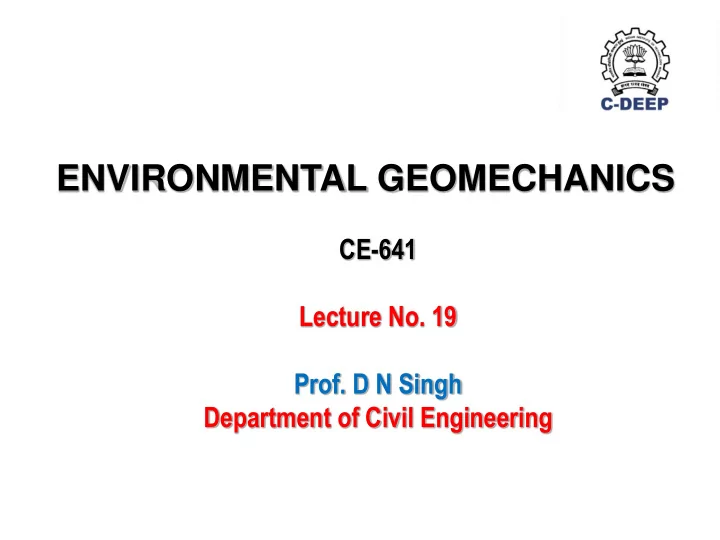

ENVIRONMENTAL GEOMECHANICS CE-641 Lecture No. 19 Prof. D N Singh Department of Civil Engineering
28.10.2018 Lecture No. 19 Lecture Name: Geomaterial Characterization Sub-topics • Cracking Characteristics • Electrical Characterization • Magnetic Characterization
Cracking Characteristics of Fine-grained Soils • Fine-grained soils such as clays, expansive soils, active clay minerals are prone to cracking (development of shrinkage cracks) due to loss of moisture (drying) • Occurs in earthen dams, landfill liners & covers (Radioactive wastes), embankments, earth slopes, cricket pitches, tennis courts/turfs etc. • Understanding of cracking is necessary for assessing the safety of structures built on or with soil mass The cracked soil mass would exhibit extremely high hydraulic conductivity, gas permittivity and reduced strength (and hence soil may not be useful for containment). Linked with tensile strength of soils
Cracking of Structural Fills Typical cracking patterns Measurement of crack propagation depth
Crack Development: Conceptual Model Due to the buildup of tensile stresses (on drying of the soil mass)
Mechanisms of Mobilization of The Tensile Strength Soil considered to be a ‘Three phase system (Soil -Water-Air interaction ) Dry soil : apparent cohesion Partially saturated soils: Surface tension Tensile strength plays a vital role in cracking of the soils Soils that swell, exhibit higher tensile strength σ t = f( w, t , soil type, CL, CEC, PI, SSA, ψ )
Tensile strength Sensitivity Sensitivity shear strength of soil in undisturbed and remolded forms Type of loading tensile compressive shear Maximum most exposed surface critical area
Effect of External Loading on the Soil Mass Tensile loading: Exposition of greater surface area of grains and hence more activity or reactivity Compression loading: Reduction in the exposed surface area of grains and hence less activity
Determination of Tensile Strength of soils Based on softwares Direct measurement and image analysis Laboratory or in situ Accurate ( & direct) measurement of crack pattern, geometry, area included in each segment, intersection of cracks and its initiation is a difficult and cumbersome task. Linking these parameters to basic soil properties (Physico-chemico- mineralogical) and its unsaturated sate (as soil dries up) has not been done yet. These investigations should yield a generalized model that would imbibe: Soil Properties Environmental Conditions Loading Conditions Sample size
Triaxial tests 1000 MT ( 3 ) kPa 25 50 100 200 300 800 d (kPa) 600 400 200 0 0 2 4 6 8 10 12 14 16 (%)
Empirical Relationships from the Literature σ t =f(LL, PI, CEC, CL, ψ, A c ) σ t = 632.10+38.23 CL σ t =7.6 CL-59.2 σ t = -5.77(w-w omc )+29.4 σ t =1.2.LL- 4.8, σ t =2.1.PI+9.3, σ t =1.15.CL+9.0 σ t = 31.44+1.24 PI -0.018 PI 2 +0.00011 PI 3 σ t = 39.8 - 850.33/(1+exp(Ac+2.29)/0.67 ) log (σ t )= 5.12 – 2.32 log(w) σ t = -39+16.7 CEC σ t = -125.21+21.10 CEC σ t = 638.46+(-106.02-638.46)/(1+( ψ /1105.72) 1.109 ) σ t =10.3+331.2.exp{-0.5.(ln( ψ /15388.92)/2.187) 2 } σ t =-95.89+400.9/{1+exp(-( ψ -566.3)/609.49)} Incomplete Relationships, Soil and Methodology Dependent and are not generalized (only a few parameters are involved)
Generalized Relationships σ t = 0.01 CL 1.5 CEC 0.5 ψ 0.5 σ t is tensile strength CL is clay content σ t = CL 0.5 CEC CEC is cation exchange capacity ψ is suction 700 Three parameters relation ship Two parameters relationship 600 Triaxial test results 500 400 t(Com) 300 200 100 0 0 100 200 300 400 500 600 700 t(Mes)
Development of Crack patterns over prolonged durations (due to loss of moisture) Direct Images
Image Analysis
Image Analysis of the Crack CW is average crack width CW max maximum crack width : volumetric moisture content s : volumetric moisture content at saturation a : soil dependent parameter
3-D Laser microscopy Laser Microscopy OLS LEXT-4000 (Olympus, Japan)
Measurement of Tensile Stress in Thin Films Experimental setup (Shinde, 2009) Position Sensitive Detector X Laser Source L2 L1 Soil sample Deflection Angle Clamped Silicon wafer
Computation of Tensile Stress 2.4 MT T12,5 3 2.0 E t X(t) σ 1 s s tan (t) X (V) f 12 t (t) L t t (t) L f f s f Laser 1.6 t t (t) t E t f S 1 r f fo f t fo 8 1.2 0 500 1000 1500 2000 2500 MT T4,6 t (sec) 7 20 6 MT T12,5 5 16 W (mg) (806,13) Stress (kPa) 4 12 E o = 4.57 10 -6 g/s 3 8 2 4 1 t cr 0 0 0 200 400 600 800 1000 1200 1400 1600 0 400 800 1200 t (s) t (sec)
SEM Micrographs SEM images of wafer specimen (MT) after completion of test 50X 250 X 500X 2000 X
Important Relationships 200 σ t = a·(S f ) b 150 t (kPa) 100 50 100 L/S 90 5 6 7 8 9 σ t = c·(L/S) d 80 0 0 10 20 30 40 50 60 70 80 90 100 70 S f (%) t (kPa) 60 50 40 30 20 2 = 0.85 R 10 0 0 1 2 3 4 5 6 7 8 9 10 L/S
Self-healing/Self Sealing Minerals Minerals which posses built-in ability to stop swelling/shrinking and cracking properties Intelligent minerals Their synthesis, characterization and application in various projects (related to Civil, Geotechnical Engineering, Concrete etc.) is a real challenge
Recommend
More recommend